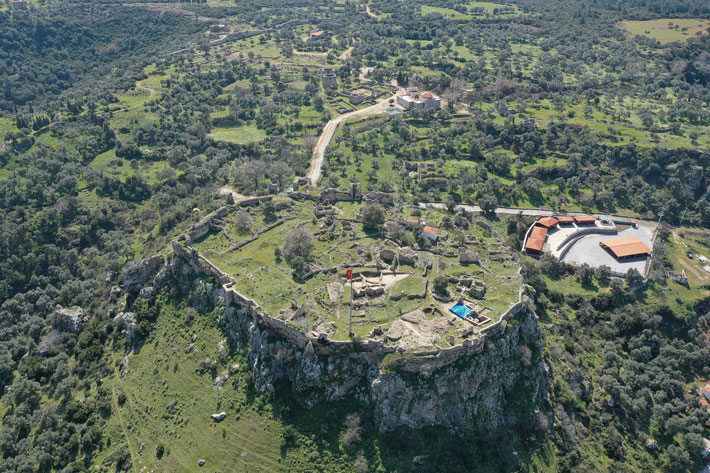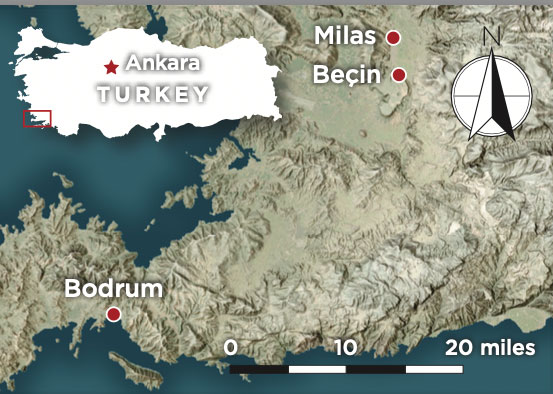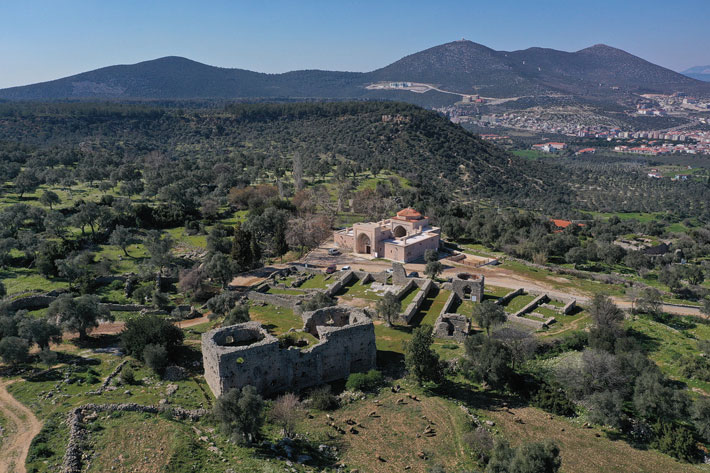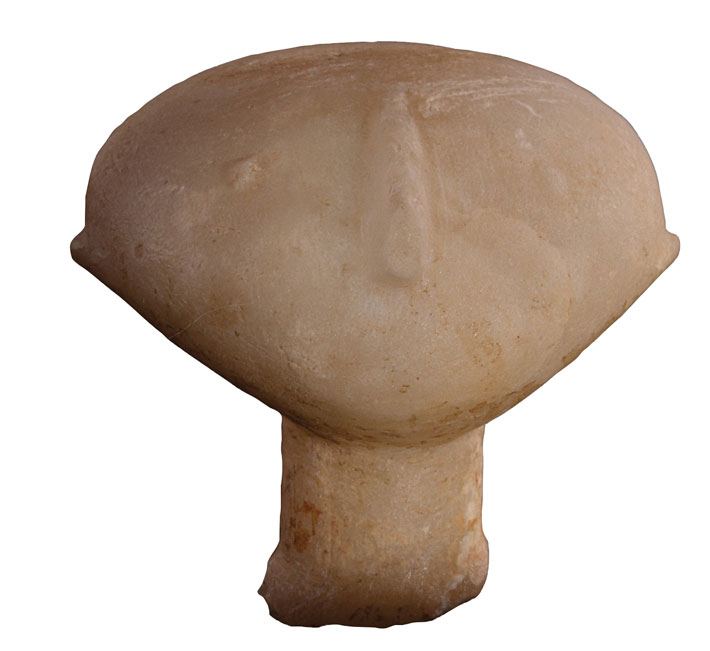Off the Grid
Beçin, Turkey
March/April 2024
 Perched on the Mutluca Plateau in southwestern Turkey’s Muğla Province, the medieval walled city of Beçin was built on the ruins of a site whose history began thousands of years before. Based on the discovery of walls beneath the fortified inner citadel, archaeologists believe that a permanent settlement existed there by at least the fourth century B.C., during the Classical period, when the site was part of the Greek-controlled region of Caria. The settlement was continuously occupied throughout the subsequent Hellenistic, Roman, and Byzantine periods. In the 1260s, a Muslim emir named Menteşe, who had founded an eponymous principality, conquered Caria. Beçin likely fell to the principality during the reign of Menteşe’s son and successor, Mesud Bey, who solidified control of the southwestern Anatolian coast. After Mesud’s death in 1319, his son, Orhan Bey, made Beçin the capital of the principality. The city flourished over the next century, as rulers of Menteşe built mosques, baths, and fountains with opulently carved facades and established Islamic schools called madrassas. At its height, Beçin was home to between 8,000 and 10,000 people, many of whom lived in courtyard houses along meticulously planned streets.
Perched on the Mutluca Plateau in southwestern Turkey’s Muğla Province, the medieval walled city of Beçin was built on the ruins of a site whose history began thousands of years before. Based on the discovery of walls beneath the fortified inner citadel, archaeologists believe that a permanent settlement existed there by at least the fourth century B.C., during the Classical period, when the site was part of the Greek-controlled region of Caria. The settlement was continuously occupied throughout the subsequent Hellenistic, Roman, and Byzantine periods. In the 1260s, a Muslim emir named Menteşe, who had founded an eponymous principality, conquered Caria. Beçin likely fell to the principality during the reign of Menteşe’s son and successor, Mesud Bey, who solidified control of the southwestern Anatolian coast. After Mesud’s death in 1319, his son, Orhan Bey, made Beçin the capital of the principality. The city flourished over the next century, as rulers of Menteşe built mosques, baths, and fountains with opulently carved facades and established Islamic schools called madrassas. At its height, Beçin was home to between 8,000 and 10,000 people, many of whom lived in courtyard houses along meticulously planned streets.
 By 1426, the principality of Menteşe was under the control of the Ottoman Empire. The neighboring city of Milas became the region’s political center, and Beçin’s importance waned. “Since it was gradually abandoned over time, Beçin stands out as one of the rare Turkish cities in Anatolia whose citadel and walled settlement have been preserved in their original form to the present day,” says archaeologist Kadir Pektaş of Istanbul Medeniyet University. “Beçin represents a transition between the principality and the Ottoman period, where interesting syntheses in architecture and urbanism developed.”
By 1426, the principality of Menteşe was under the control of the Ottoman Empire. The neighboring city of Milas became the region’s political center, and Beçin’s importance waned. “Since it was gradually abandoned over time, Beçin stands out as one of the rare Turkish cities in Anatolia whose citadel and walled settlement have been preserved in their original form to the present day,” says archaeologist Kadir Pektaş of Istanbul Medeniyet University. “Beçin represents a transition between the principality and the Ottoman period, where interesting syntheses in architecture and urbanism developed.”
Although archaeologists have investigated Beçin since the 1970s, excavations have only recently begun in and around the walls of the inner citadel. Pektaş leads a team that is restoring many of the extant structures and unearthing traces of the city’s history dating back to its earliest inhabitants. Among these finds are the head of a more than 5,000-year-old idol of a type popularly known as a stargazer, a fifth- or fourth-century B.C. mausoleum and well filled with figurines and pottery, and a gold coin minted by the Persian ruler Darius I (reigned 522–486 B.C.).
 THE SITE
THE SITE
Visitors can follow signs to take a self-guided tour of Beçin’s residential quarter and public buildings. Among the notable ruins are the Büyük Hamam, the city’s largest marble-floored bathhouse; Kızıl Han, a two-story caravansary; and the recently restored Yelli Mosque and Bey Pool. A monumental gateway leads visitors into the Ahmed Gazi Madrasa, which was built in 1375. Exhibits inside chart the architectural development of madrassas as well as the daily activities and lessons that took place within the schools. The structure also houses the Stone Works Museum, a collection of Menteşe- and Ottoman-period tombstones unearthed at Beçin and Milas.
 WHILE YOU’RE THERE
WHILE YOU’RE THERE
Milas, just three miles to the north, is famed for its vibrantly colored handwoven wool carpets. Visitors should be sure to sample local culinary delicacies such as sour meatballs and a savory quiche-like dish called çaykama. In the city center is the Tomb of Hecatomnus, the fourth-century B.C. ruler of Caria and father of Mausolus, who was entombed in the Mausoleum of Halicarnassus—one of the Seven Wonders of the Ancient World. Pektaş recommends touring other ancient Greek and Persian cities within a short driving distance, including Iasus, Euromus, Labraunda, and Latmus-Heracleia. About an hour’s drive southwest of Milas is the Bodrum Museum of Underwater Archaeology, which displays artifacts recovered from the Aegean’s most famous ancient shipwrecks.
Advertisement
IN THIS ISSUE
Digs & Discoveries
Painting by Roman Numerals
The Parthenon’s Paint Job
Six Centuries of the Condor
Spells Against Snakes
Paleo Palette
Mohenjo-Daro’s Buddhist Past
Cuts Like a Shark
Neolithic Honey Hunters
Watchdog for the Afterlife
Update: Royal Rendlesham
Off the Grid
Around the World
Earliest archers in the Americas, sounds of a spirit cave, Tibetan yak herders, joining up with Caesar, and the first Buddhist king of the Khmer Empire
Artifact
Don’t forget your basket
Advertisement

Recent Issues
-
 May/June 2024
May/June 2024
-
 March/April 2024
March/April 2024
-
 January/February 2024
January/February 2024
-
 November/December 2023
November/December 2023
-
 September/October 2023
September/October 2023
-
 July/August 2023
July/August 2023
-
 May/June 2023
May/June 2023
-
 March/April 2023
March/April 2023
-
 January/February 2023
January/February 2023
-
 November/December 2022
November/December 2022
-
 September/October 2022
September/October 2022
-
 July/August 2022
July/August 2022
-
 May/June 2022
May/June 2022
-
 March/April 2022
March/April 2022
-
 January/February 2022
January/February 2022
-
 November/December 2021
November/December 2021
-
 September/October 2021
September/October 2021
-
 July/August 2021
July/August 2021
-
 May/June 2021
May/June 2021
-
 March/April 2021
March/April 2021
-
 January/February 2021
January/February 2021
-
 November/December 2020
November/December 2020
-
 September/October 2020
September/October 2020
-
 July/August 2020
July/August 2020
-
 May/June 2020
May/June 2020
-
 March/April 2020
March/April 2020
-
 January/February 2020
January/February 2020
-
 November/December 2019
November/December 2019
-
 September/October 2019
September/October 2019
-
 July/August 2019
July/August 2019
-
 May/June 2019
May/June 2019
-
 March/April 2019
March/April 2019
-
 January/February 2019
January/February 2019
-
 November/December 2018
November/December 2018
-
 September/October 2018
September/October 2018
-
 July/August 2018
July/August 2018
-
 May/June 2018
May/June 2018
-
 March/April 2018
March/April 2018
-
 January/February 2018
January/February 2018
-
 November/December 2017
November/December 2017
-
 September/October 2017
September/October 2017
-
 July/August 2017
July/August 2017
-
 May/June 2017
May/June 2017
-
 March/April 2017
March/April 2017
-
 January/February 2017
January/February 2017
-
 November/December 2016
November/December 2016
-
 September/October 2016
September/October 2016
-
 July/August 2016
July/August 2016
-
 May/June 2016
May/June 2016
-
 March/April 2016
March/April 2016
-
 January/February 2016
January/February 2016
-
 November/December 2015
November/December 2015
-
 September/October 2015
September/October 2015
-
 July/August 2015
July/August 2015
-
 May/June 2015
May/June 2015
-
 March/April 2015
March/April 2015
-
 January/February 2015
January/February 2015
-
 November/December 2014
November/December 2014
-
 September/October 2014
September/October 2014
-
 July/August 2014
July/August 2014
-
 May/June 2014
May/June 2014
-
 March/April 2014
March/April 2014
-
 January/February 2014
January/February 2014
-
 November/December 2013
November/December 2013
-
 September/October 2013
September/October 2013
-
 July/August 2013
July/August 2013
-
 May/June 2013
May/June 2013
-
 March/April 2013
March/April 2013
-
 January/February 2013
January/February 2013
-
 November/December 2012
November/December 2012
-
 September/October 2012
September/October 2012
-
 July/August 2012
July/August 2012
-
 May/June 2012
May/June 2012
-
 March/April 2012
March/April 2012
-
 January/February 2012
January/February 2012
-
 November/December 2011
November/December 2011
-
 September/October 2011
September/October 2011
-
 July/August 2011
July/August 2011
-
 May/June 2011
May/June 2011
-
 March/April 2011
March/April 2011
-
 January/February 2011
January/February 2011
Advertisement





